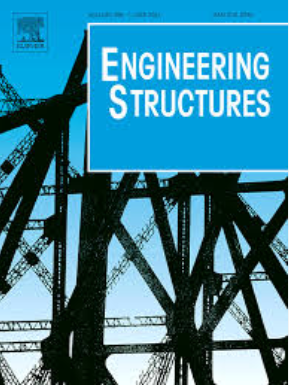Bragg scattering-driven anisotropic metabeam with multi-scale architecture for ultra-broadband vibration suppression at high structural stiffness
IF 5.6
1区 工程技术
Q1 ENGINEERING, CIVIL
引用次数: 0
Abstract
Despite advancements in metamaterial beams, practical applications remain limited by narrow bandgaps, excessive mass, and stiffness compromises. This study presents a single-phase lightweight anisotropic metabeam leveraging Bragg scattering and hierarchical architecture optimization to achieve concurrent ultra-low frequency and ultra-broadband vibration suppression while preserving high stiffness. A novel non-locality homogenization method (NLHM) integrating variational asymptotic formulations and continuum mechanics is developed, enabling efficient prediction of static-dynamic properties with more than 90 % computational efficiency gain over traditional finite element method. Experimental characterization reveals triaxial stiffness anisotropy (x/z-direction modulus exceeding y-direction by 41.2 times and 56.8 times) and triphasic Poisson’s ratio behavior (–0.05 ≤ ν ≤ 0.42). Strategic exploitation of wave polarization in anisotropic media facilitates tri-modal vibration attenuation, achieving record relative bandwidths (ΔG) of 188.2 % (P-wave), 174.1 % (SH-wave), and 192.8 % (SV-wave). The metabeam demonstrates up to 59.8 dB peak attenuation and nearly 95 % wave confinement efficiency validated through laser vibrometry. This work establishes a paradigm for engineering multifunctional metamaterials through microstructure-mediated anisotropy, advancing the design of lightweight, high-stiffness vibration control systems.
Bragg散射驱动的多尺度结构各向异性元梁在高结构刚度下的超宽带振动抑制
尽管在超材料梁方面取得了进步,但实际应用仍然受到窄带隙、质量过大和刚度妥协的限制。该研究提出了一种利用布拉格散射和分层结构优化的单相轻质各向异性元梁,在保持高刚度的同时实现超低频和超宽带的同步振动抑制。提出了一种新的非局域均匀化方法(NLHM),将变分渐近公式与连续介质力学相结合,能够有效地预测静动力特性,比传统的有限元方法计算效率提高90 %以上。实验表征显示三轴刚度各向异性(x/z方向模量分别超过y方向41.2倍和56.8倍)和三相泊松比行为(-0.05 ≤ν≤0.42)。在各向异性介质中有策略地利用波极化有利于三模态振动衰减,实现了创纪录的相对带宽(ΔG),分别为188.2 % (p波)、174.1 % (sh波)和192.8 % (sv波)。通过激光测振验证,metbeam的峰值衰减高达59.8 dB,波约束效率接近95% %。这项工作通过微观结构介导的各向异性为工程多功能超材料建立了一个范例,推进了轻量化、高刚度振动控制系统的设计。
本文章由计算机程序翻译,如有差异,请以英文原文为准。
求助全文
约1分钟内获得全文
求助全文
来源期刊

Engineering Structures
工程技术-工程:土木
CiteScore
10.20
自引率
14.50%
发文量
1385
审稿时长
67 days
期刊介绍:
Engineering Structures provides a forum for a broad blend of scientific and technical papers to reflect the evolving needs of the structural engineering and structural mechanics communities. Particularly welcome are contributions dealing with applications of structural engineering and mechanics principles in all areas of technology. The journal aspires to a broad and integrated coverage of the effects of dynamic loadings and of the modelling techniques whereby the structural response to these loadings may be computed.
The scope of Engineering Structures encompasses, but is not restricted to, the following areas: infrastructure engineering; earthquake engineering; structure-fluid-soil interaction; wind engineering; fire engineering; blast engineering; structural reliability/stability; life assessment/integrity; structural health monitoring; multi-hazard engineering; structural dynamics; optimization; expert systems; experimental modelling; performance-based design; multiscale analysis; value engineering.
Topics of interest include: tall buildings; innovative structures; environmentally responsive structures; bridges; stadiums; commercial and public buildings; transmission towers; television and telecommunication masts; foldable structures; cooling towers; plates and shells; suspension structures; protective structures; smart structures; nuclear reactors; dams; pressure vessels; pipelines; tunnels.
Engineering Structures also publishes review articles, short communications and discussions, book reviews, and a diary on international events related to any aspect of structural engineering.
 求助内容:
求助内容: 应助结果提醒方式:
应助结果提醒方式:


